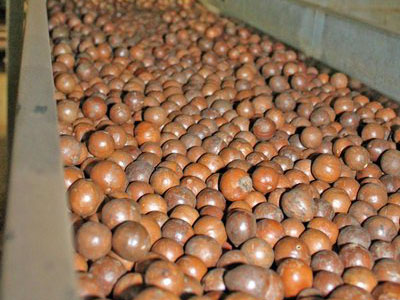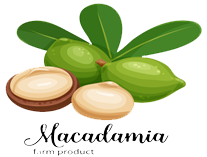The Macadamia
Brief
Neal (1965) describes the macadamia nut tree as a fast growing, regular-shaped, medium-sized tree with heavy, dark green foliage. Leaves develop in whorls of three, paired, or in fours. The leaves are rarely solitary. The leaves are blunt tipped, oblong, 1 foot in length or more, edged with fine teeth, and the petioles are about half an inch in length. The flowers are small, whitish, tasselled, and grow on long spikes. The nuts ripen in the fall, both the spring and fall, or through the year. The nut is encased in a leathery two valved case that is 1 inch in diameter. The case encloses one spherical nut or two hemispherical nuts. The nuts have a smooth hard shell that encases a white kernel.
The highest quality macadamia kernels are free of defects and insect and fungal damage, and they contain at least 72% oil. Kernels with less than 72% oil are usually immature and harder, and they become over brown when roasted. The kernel is the main product from the macadamia nut tree. After harvesting, the husks covering the nuts are removed. The nuts are fried, the shells are cracked, and the kernels are removed to be oil-roasted or dry-roasted. Kernels are commonly sold as snack nuts and chocolate-covered candy. Ice cream
manufacturers and the baking industry also use macadamia kernels as an ingredient.
The shell and husk also have uses. Shells can be used as a mulch, fuel for processing macadamia nuts, planting medium for anthurium culture, plastic manufacture and as a substitute for sand in the sand-blasting process. Husks are used as mulch or composted for fertilizer.
Oil can be extracted from culled nuts. The cosmetic industry, especially in Japan, uses the oil in soaps, sunscreens and shampoos. The remaining press cake might be used for animal feed.
Processing
Processing Macadamia Nuts
Technology used for preparing macadamia nuts for the market is constantly being improved for speed and efficiency. The major concerns of processors are kernel damage, contamination, product availability and distribution.
From farm to factory
Most macadamia nut processing plants are situated close to growing districts. The nut-in-shell farm produce is delivered to the plant where it is stored in to dryers. Processing takes place from about February to November when the factory ceases operation until the next season begins. During down-time the plant machinery is cleaned, serviced and upgraded ready for next year’s crop.
Drying
Drying of the nuts-in-shell is a critical step in the processing of macadamias. At harvest, moisture content of the nuts is approximately 30% and the kernel fills the entire shell, but after about 3 weeks of drying this is reduced to around 1.5% and the kernel shrinks away from the shell. The shell can then be cracked without damaging the kernel and nut-in-shell storage life is prolonged. Nuts can be stored in their shell for up to two years.
Cracking
Modern machines have been perfected to crack the nuts without damaging the kernel. There are two main types in use: the fixed plate with cutting blade and combination rollers and base plate to compress the shell.
Sorting and Grading
Many methods are employed for separating the kernel from broken shell, including hand sorting, screens, flotation, air separators and state of the art electronic colour sorters. These sorters differentiate between the dark brown colour of shell and the creamy colour of kernel and remove the shell fragments with a burst of compressed air. A final hand sorting inspection is carried out, to remove poor quality kernel. Grading of styles and qualities is usually achieved using rotating screens.
Packing and Storage
Long-life storage is another positive attribute of macadamia nuts and this can be further enhanced by the use of nitrogen flushed, vacuum sealed containers that prevent oxidisation and rancidity.
Nutritional Value
A one ounce oil-roasted macadamia nut (approximately 10-12 whole kernels) has 204,000 calories, 21.73 grams of fat, 2.06 grams of protein, 3.66 grams of carbohydrates, 13 milligrams of calcium, 33 milligrams of magnesium, 57 milligrams of phosphorus, 94 milligrams of potassium, and 2 milligrams of sodium.

